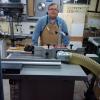I’ve been dealing with an issue with my Laguna Fusion classic table saw for over two years now and wanted to throw it out there to see if anyone has any advice. I’ve spent way too much time searching to see if anyone else has had this issue but can’t find anything about it. All I read is how great these saws are which I admit is a little frustrating when mine’s not working.
I’ll go to turn the table saw on and get a low hum and a little wiggle of the blade. Within a couple seconds the thermal switch mounted to the motor will pop. At the time this issue began I had absolutely zero experience dealing with induction motors so off to the internet I went.
The saws were still relatively new at the time so finding anything about them at all online was rare. I did however read about an issue with the early runs of the Fusion series’ thermal switch being faulty so that was my first diagnosis. I called Laguna who told me that that was true but that my serial number was past the point of that particular issue. They suggested to me that it might instead be the run capacitor.
At the time this happened I was just a month outside of my warrantee. They were super nice about it and shipped me out a new one free of charge anyway . I was able to install it easy enough even though it meant removing the motor from the saw. After I installed it I gave it a test run outside the saw and it ran just fine. However once mounted back in the saw, with the spindle under load, the problem continued. Only this time I could get a few rotations before the cutoff engaged. I found that I could sometimes persuade the saw to run by cycling on/off/on. Being in the middle of a small production run, I went with this until I had time to address it again.
This was how I ran for about six months before that process stopped working. I did a bunch more research and found out it was more likely the run capacitor that was the problem rather than the start capacitor but that the coils should be checked for burning as well.
I actually had the balls to disassemble the motor to check the coils and everything looked good. I searched all over for the equivalent run capacitor (35uf 300VAC) and couldn’t find one. It’s apparently unique to this motor and is much smaller than any other capacitor in its rating. So I had to call Laguna to get a new run one. I got one for like $24, installed it, and the saw ran like new. For about another 6 months.
I’m back where I started and I know it’s not normal to have to replace capacitors on a motor this frequently. Has anyone has this issue before? with Laguna or any other saw?





 Reply With Quote
Reply With Quote



